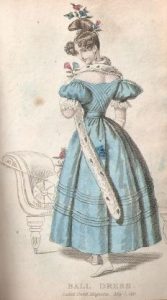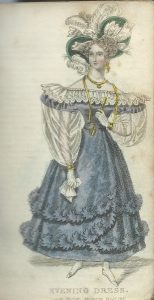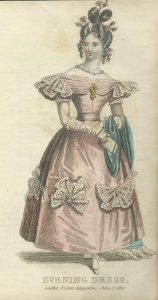My copy of this must-have book for the fashionable lady in 1831 is conveniently pocket-sized and comprises 244 pages of short stories, poems, articles on famous women, dozens of ‘preceptive distichs’, fashion advice and twenty-seven illustrations, including some ravishing hand-coloured fashion plates. Unfortunately, a number of the plates have been torn out. Still, enough remain to give a good idea of what The Ladies’ Pocket Magazine would have looked like.

Blue ball dress 1831
The fashion advice discusses the fashion plates in the pages following their illustrations; for example, with regard to the picture above, we learn that the ball dress is ‘etherial (sic) blue tulle over satin; the corsage is cut very low… Beret sleeves finished en manchette, with blond lace. The skirt is trimmed with six rouleaux… The hair is arranged in bands, and bows on the summit of the head, and in curls at the sides of the face, and adorned with light sprigs of blue and rose-coloured fancy flowers…. Swansdown boa tippet. ’
It’s also obvious, from the model’s elaborate hair style, that a lady’s maid is a must. ‘Manchette’ means cuff or ruffle; personally, I’d have called them frills, but, doubtless en manchette sounds more haute couture.
The fashion section continues with news on what’s in and what’s out – ‘Dunstable straw bonnets are in and this Season’s colours are emerald green, azure blue, lilac, rose and canary-yellow. In Paris, blond lace is very popular and, for jewellery, it’s gold and emeralds.’

Reading lady
There are a number of small black and white ‘embellishments’ in the magazine and the magazine opens with this print of a reading lady. Underneath is written: Richard Ryan to a Young Lady: on seeing her reading a volume of his poems . This is followed by the poem itself. The poem ends: Say, what avails it, when I’m gone / What future ages think of me? /Oh, dearer far to know that one / Approves me now, and that is thee.
The ‘preceptive distichs’ mentioned in the List of Contents are moral maxims, e.g:
Avoid voluptuous pleasure in your prime –
Your days will last and you enjoy their time.
Or
Avoid the dice, destruction’s net and snare;
The rich man’s prison and the poor man’s fare.
I’m not sure what the second line means but the general sentiment is clear enough.

Violet evening dress
The written description of this violet-coloured satin is illegible in places. The illustrations are hand-coloured and occasionally, as here, the paint was still a touch wet and left a smear on the opposite page which obscured some of the description.
However, I can read some of it: ‘The border is trimmed with crepe ruches to correspond with the dress, they form wreaths of a singularly novel and pretty appearance; one is arranged near the lower edge of the hem, the other considerably higher. The head-dress is a green velvet beret, the brim formed en coeur is decorated with white gauze ribbon, disposed en tulippe on the inside; five white ostrich feathers, which fall in contrary directions, are placed in front of the crown.’
I have to say that I’m not a fan of those absurdly wide shoulders.

Lady Jane Grey solicited to accept the crown
There are a also number of articles on famous women. The Lady Jane Grey engraving is accompanied by a poem by a Miss Leslie which begins:
Oh, not for me, oh not for me, /That fatal toy of gems and gold…
Some of The Lady’s Pocket Magazine’s comments on famous women are, frankly, bizarre. Take this one on Anne Boleyn: ‘We think she remained a girl after she was a wife – a pretty, tittering partner in a dance, but devoid of the mind and steadiness suited to the conjugal state.’
Not a view of the forceful, intelligent and sophisticated Anne we hold today!

Charles Barford with Lucy and Emily
The short story, Flirtation – a Tale of Modern Times has interesting echoes of Lydia Bennet. When the regiment comes to town, the lovely Emily’s attention wanders from the eligible Charles, who adores her, to the fascinating Colonel Darlington … Will Emily come to her senses before Charles runs out of patience? Or will Charles turn to her sensible older sister, Lucy?
Alas, poor Lucy doesn’t even get a look in; at twenty-seven, she’s far too old. Though, if I were editor, I’d demand that Charles dumps the tiresome Emily and goes for sensible Lucy instead.

Pink evening dress, 1831
This is what the magazine has to say about the above garment. ‘A dress of rose-coloured crepe over satin to correspond; the corsage is cut square, of a delicate height, it is draped à la grecq (sic), and bordered with blond lace. Beret sleeve, surmounted by an epaulette, composed of square ends of rose-coloured ribbon … The trimming of the skirt consists of nœuds (knots) to correspond… The hair is dressed in a few loose ringlets at the sides of the face, and in full bows on the forehead, and on the crown of the head; it is ornamented with rose-coloured fancy flowers.’
The hair looks fiendishly difficult to do, though, from the way it’s described, one feels that any half-competent lady’s maid should be able to do it in a trice. And what on earth does ‘a delicate height’ mean?

The birthplace of Robert Burns
Occasionally, the magazine allows a small article about more serious literature, see the illustration above. Underneath it is a short description of Burns’ birthplace; the cottage was actually built by the poet’s father, and we have the description of it in a quote from Burns’ The Cotter’s Saturday Night. The article ends with the note that ‘the house has been turned into a snug public house’ and the landlord has pinned up the following inscription by the door: Halt, passenger, and read; / This is the humble cottage, / That gave birth to the celebrated /Poet, Robert Burns.
The Ladies’ Pocket Magazine tells us a lot about the period: what ladies wore, what they read and how they thought. Or, perhaps, it might be more accurate to say, what the, presumably, male editor thought they should be reading and thinking.
Elizabeth Hawksley
Please share this page...
I love the sound of this book. Exactly the kind of thing that gives a real feel for the times. Fascinated by the use of beret to describe both the hat and then the sleeves of another dress. I just wonder what they meant by it at the time. The hat is obviously not what we would call a beret now. But the sleeve gathers into the arm and that kind of fits. But I suspect it meant something other than our notion of a beret.
I’ve been wondering about the mysterious ‘beret’, too, Elizabeth. I looked it up in my French dictionary – which was helpful for words like ‘manchette’ – but it said only, ‘cap’ or ‘Tam o’ Shanter’. As far as I can make out, the 1831 ‘beret’ meant a complicated hat with ribbons etc coming off in different directions – and maybe the beret sleeve was similar.
My ‘Handbook of English Costume in the 19th Century’ mentions the ‘beret’ several times but, unfortunately, doesn’t define it.